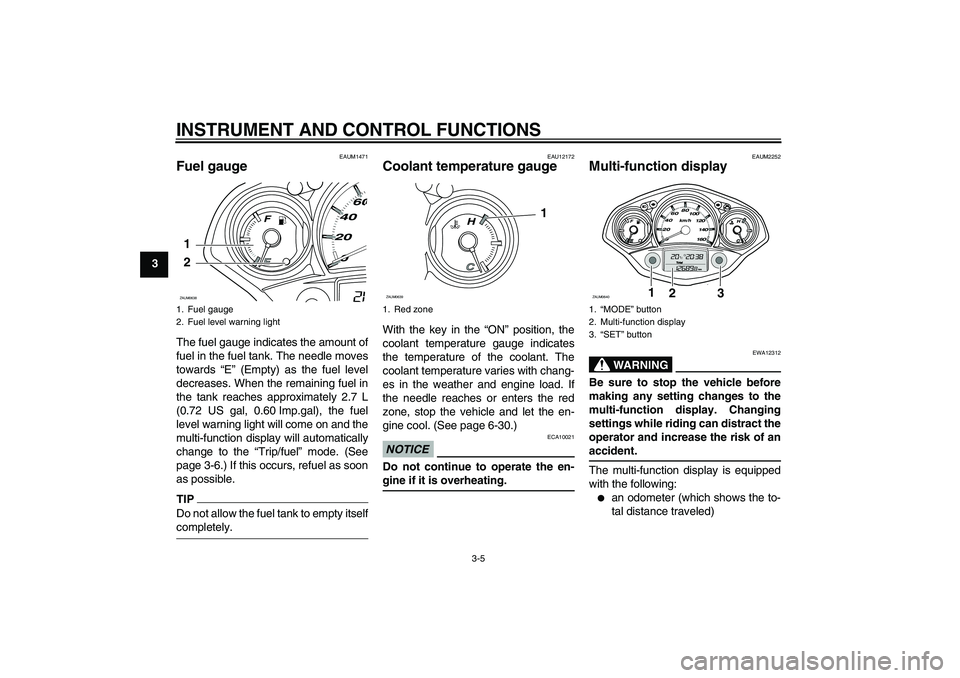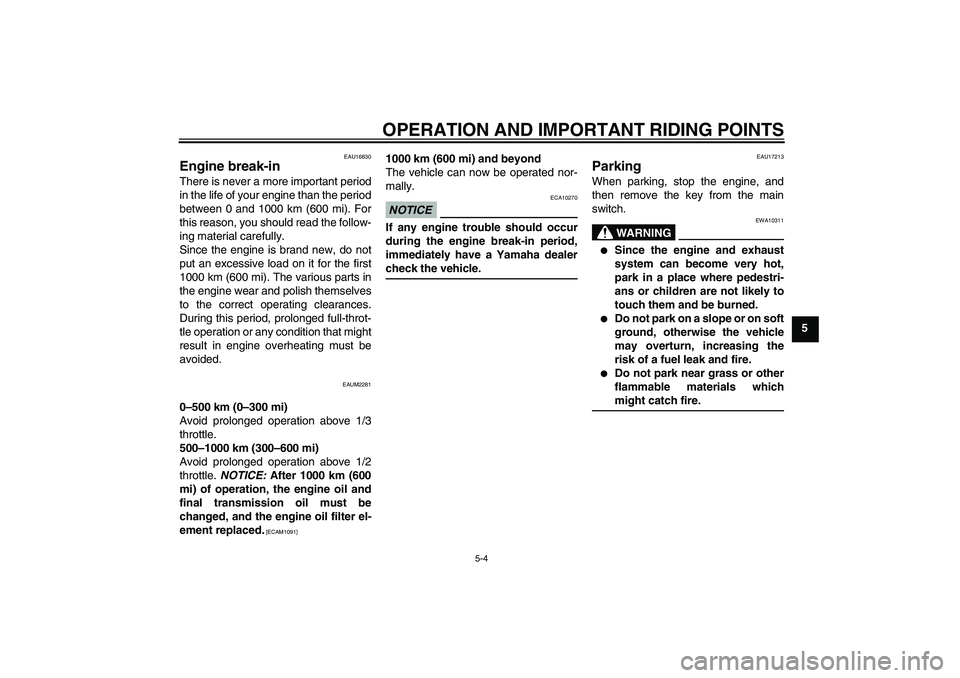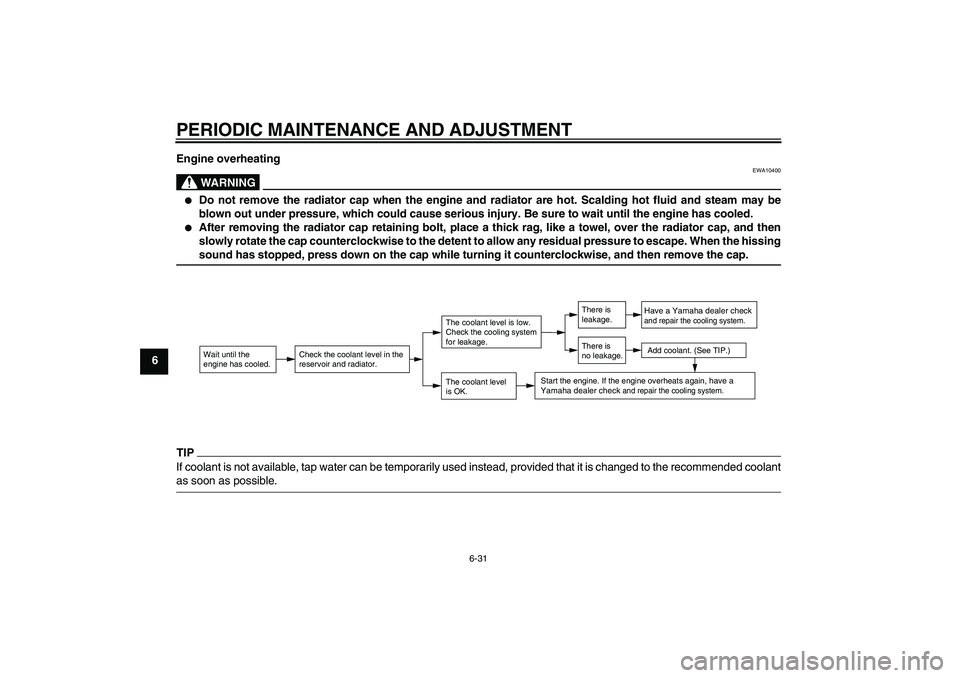Page 20 of 82

INSTRUMENT AND CONTROL FUNCTIONS
3-5
3
EAUM1471
Fuel gauge The fuel gauge indicates the amount of
fuel in the fuel tank. The needle moves
towards “E” (Empty) as the fuel level
decreases. When the remaining fuel in
the tank reaches approximately 2.7 L
(0.72 US gal, 0.60 Imp.gal), the fuel
level warning light will come on and the
multi-function display will automatically
change to the “Trip/fuel” mode. (See
page 3-6.) If this occurs, refuel as soon
as possible.TIPDo not allow the fuel tank to empty itselfcompletely.
EAU12172
Coolant temperature gauge With the key in the “ON” position, the
coolant temperature gauge indicates
the temperature of the coolant. The
coolant temperature varies with chang-
es in the weather and engine load. If
the needle reaches or enters the red
zone, stop the vehicle and let the en-
gine cool. (See page 6-30.)NOTICE
ECA10021
Do not continue to operate the en-gine if it is overheating.
EAUM2252
Multi-function display
WARNING
EWA12312
Be sure to stop the vehicle before
making any setting changes to the
multi-function display. Changing
settings while riding can distract the
operator and increase the risk of anaccident.
The multi-function display is equipped
with the following:�
an odometer (which shows the to-
tal distance traveled)
1. Fuel gauge
2. Fuel level warning light1
2ZAUM0638
1. Red zone
1
ZAUM0639
1.“MODE” button
2. Multi-function display
3.“SET” button
1
2
3
ZAUM0640
U16PE1E0.book Page 5 Monday, July 28, 2008 9:57 AM
Page 39 of 82

OPERATION AND IMPORTANT RIDING POINTS
5-4
5
EAU16830
Engine break-in There is never a more important period
in the life of your engine than the period
between 0 and 1000 km (600 mi). For
this reason, you should read the follow-
ing material carefully.
Since the engine is brand new, do not
put an excessive load on it for the first
1000 km (600 mi). The various parts in
the engine wear and polish themselves
to the correct operating clearances.
During this period, prolonged full-throt-
tle operation or any condition that might
result in engine overheating must be
avoided.
EAUM2281
0–500 km (0–300 mi)
Avoid prolonged operation above 1/3
throttle.
500–1000 km (300–600 mi)
Avoid prolonged operation above 1/2
throttle. NOTICE: After 1000 km (600
mi) of operation, the engine oil and
final transmission oil must be
changed, and the engine oil filter el-
ement replaced.
[ECAM1091]
1000 km (600 mi) and beyond
The vehicle can now be operated nor-
mally.NOTICE
ECA10270
If any engine trouble should occur
during the engine break-in period,
immediately have a Yamaha dealercheck the vehicle.
EAU17213
Parking When parking, stop the engine, and
then remove the key from the main
switch.
WARNING
EWA10311
�
Since the engine and exhaust
system can become very hot,
park in a place where pedestri-
ans or children are not likely to
touch them and be burned.
�
Do not park on a slope or on soft
ground, otherwise the vehicle
may overturn, increasing the
risk of a fuel leak and fire.
�
Do not park near grass or other
flammable materials whichmight catch fire.
U16PE1E0.book Page 4 Monday, July 28, 2008 9:57 AM
Page 70 of 82

PERIODIC MAINTENANCE AND ADJUSTMENT
6-31
6Engine overheating
WARNING
EWA10400
�
Do not remove the radiator cap when the engine and radiator are hot. Scalding hot fluid and steam may be
blown out under pressure, which could cause serious injury. Be sure to wait until the engine has cooled.
�
After removing the radiator cap retaining bolt, place a thick rag, like a towel, over the radiator cap, and then
slowly rotate the cap counterclockwise to the detent to allow any residual pressure to escape. When the hissingsound has stopped, press down on the cap while turning it counterclockwise, and then remove the cap.
TIPIf coolant is not available, tap water can be temporarily used instead, provided that it is changed to the recommended coolantas soon as possible.
Wait until the
engine has cooled.
Check the coolant level in the
reservoir and radiator.
The coolant level
is OK.The coolant level is low.
Check the cooling system
for leakage.
Have a Yamaha dealer checkand repair the cooling system.Add coolant. (See TIP.)
Start the engine. If the engine overheats again,
have a
Yamaha dealer check
and repair the cooling system.
There is
leakage.
There is
no leakage.
U16PE1E0.book Page 31 Monday, July 28, 2008 9:57 AM